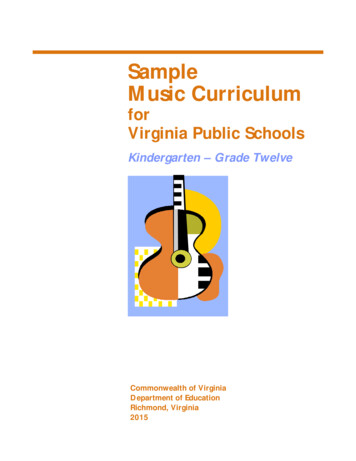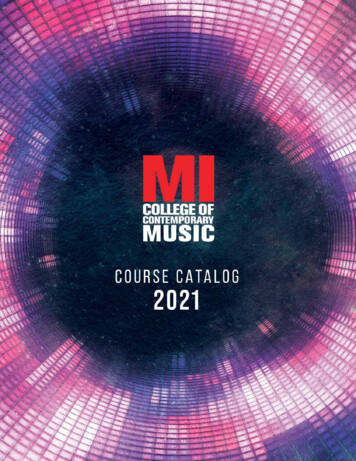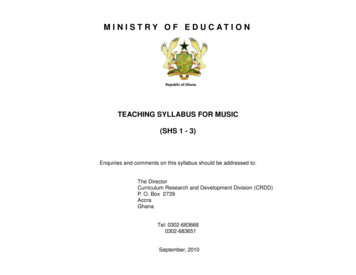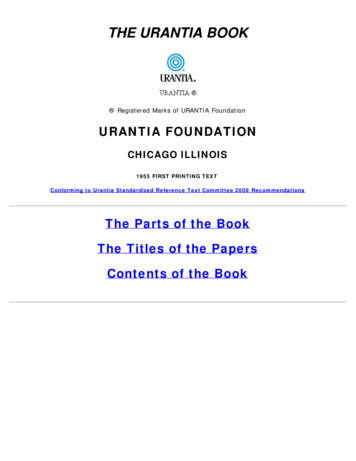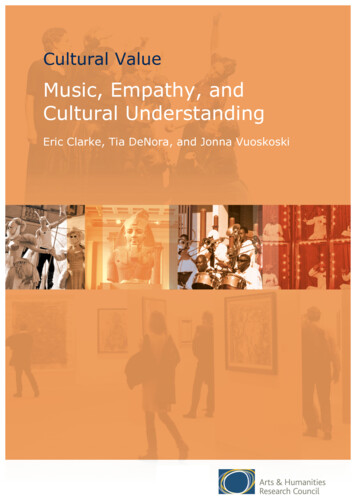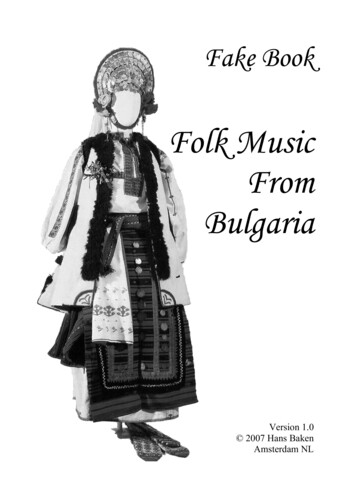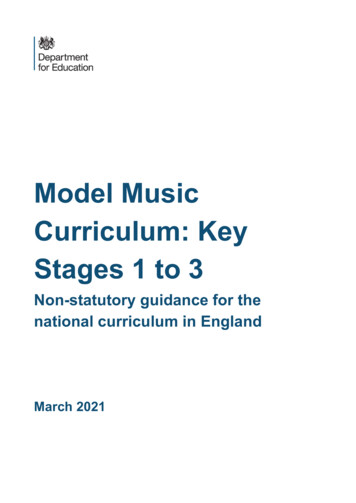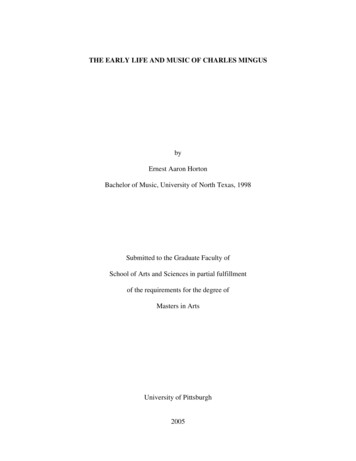
Transcription
THE EARLY LIFE AND MUSIC OF CHARLES MINGUSbyErnest Aaron HortonBachelor of Music, University of North Texas, 1998Submitted to the Graduate Faculty ofSchool of Arts and Sciences in partial fulfillmentof the requirements for the degree ofMasters in ArtsUniversity of Pittsburgh2005
UNIVERSITY OF PITTSBURGHSCHOOL OF ARTS AND SCIENCESThis thesis was presentedbyErnest Aaron HortonIt was defended onNovember 29, 2005and approved byAkin Euba, PhD, Andrew W. Mellon Professor of MusicMathew Rosenblum, PhD, Professor of MusicThesis Director:Nathan Davis, PhD, Professor of Musicii
Copyright by Ernest Aaron Horton2005iii
THE EARLY LIFE AND MUSIC OF CHARLES MINGUSErnest Aaron Horton, BMUniversity of Pittsburgh, 2005Charles Mingus has left a profound impact on the world of jazz. His career began in theearly 1940s as a bassist in the Los Angeles area. As an instrumentalist his skill was unmatched.He quickly gained a national reputation that afforded him the opportunity to work with early jazzgreats, such as Louis Armstrong and Kid Ory, contemporaries such as Dizzy Gillespie andCharlie Parker, and modern stars such as John Faddis and Toshiko Akioshi. In addition to hisability as a bassist, Mingus was a prolific composer. His creative output is often compared to themusic of Duke Ellington. He continued to write music until he fell victim to Lou Gehrig’sdisease in 1979. Through the efforts of his widow, Susan Graham Mingus, his music is stillperformed today.This paper is an examination of Mingus’ life and music through his life, the people withwhom he was acquainted, and the music that he was a part of. Among the topics explored areindividuals who had an impact on his life such as Simon Rodia, Jelly Roll Morton, DukeEllington, Britt Woodman and Buddy Collette. It will also illuminate Mingus’ philosophicalbeliefs by examining his experiences with Christianity and Hinduism.Finally, the papersystematically discusses parts of his career including his early recordings in rhythm and blues,big band, and small ensemble works, and examines his compositional style in order to facilitate agreater understanding of the origins of his later works.iv
TABLE OF CONTENTSTABLE OF CONTENTS . VLIST OF FIGURES . VIIPREFACE. IX1.0INTRODUCTION. 12.0MINGUS’ EARLY PEERS, MENTORS AND HEROES . 33.02.1.1Charles Sr. and Mamie Mingus. 42.1.2Farwell Taylor. 62.1.3Simon Rodia . 92.1.4Britt Woodman, Buddy Collette, and Other Local Musicians . 122.1.5Jelly Roll Morton and the New Orleans Influence . 142.1.6Duke Ellington. 162.1.7Red Norvo, Fats Navarro and the Impact of Race on Mingus’ Life . 18MINGUS’ EARLY ARTISTIC ENDEAVORS . 223.1MINGUS’ EARLY POPULAR MUSIC ENDEAVORS. 233.1.1The Influence of the Music of Louis Jordan. 243.1.2An Analysis of Louis Jordan’s “Let the Good Times Roll” . 293.1.3Comparing the Rhythm and Blues of Jordan and Mingus . 333.24.0MINGUS’ MORE ARTISTIC EARLY ENDEAVORS. 393.2.1Mingus’ Early Big Band Recordings . 403.2.2Mingus’ Early Compositional Sense . 42MINGUS AND BEBOP . 464.1.14.2Difference Between Mingus and Bebop Musicians. 46THE CONTRAST BETWEEN SWING AND BOP. 52v
4.2.1The Musical Conventions of Swing Using Tenor Saxophonist ColemanHawkins as a Baseline. 524.2.2The Changing Standard, Examining the Innovations of Bebop ThroughCharlie Parker. 584.2.35.0DEBUT RECORDS, MINGUS FIRST MAJOR MUSICAL STATEMENT . 745.1DEBUT’S MOST RECOGNIZED RECORDING . 755.1.1Mingus’ Musical Ascension. 755.1.2The Place of Parker in Mingus’ Life and Music . 765.26.0The Dissemination of Bebop . 71EARLY SIGNS OF MINGUS AS THE FATHER OF AVANT-GARDE. 785.2.1Lee Konitz’s Significance on Debut. 795.2.2The Place of Lennie Tristano in the Music of Charles Mingus . 805.2.3Tristano’s Experiments . 815.2.4Mingus’ Avant-Garde Music . 835.2.5Mingus’ Music and Political Messages . 84CONCLUSION. 88APPENDIX A . 89APPENDIX B . 94APPENDIX C . 98BIBLIOGRAPHY . 99vi
LIST OF FIGURESFigure 1 Ellington’s chromatic "Train" line . 17Figure 2 A Simple blues chord progression. 28Figure 3 Introductory melody for "Let the Good Times Roll" . 31Figure 4 Illustration of spatial relationships between Jordan’s vocal melodies (top line) and thepiano melody (bottom line) in "Let the Good Times Roll" . 32Figure 5 Chord changes for Louis Jordan's "Let the Good Times Roll" . 33Figure 6 Chord changes for Mingus’ "Ain't Jivin" . 34Figure 7 Mingus' bass solo introduction to "Ain't Jivin" . 38Figure 8 Schenker patterned analysis of the harmonic structure of "Weird Nightmare" . 43Figure 9 B flat major seventh to A altered seventh . 44Figure 10 Illustration of the tonicization of D minor. 45Figure 11 Standard Rhythm Changes . 53Figure 12 Analysis of melodic material in the first eight bars of Coleman Hawkins’ solo in "BoffBoff". 54Figure 13 Second measure of the second eight bars of Coleman Hawkins’ solo on "Boff Boff" 55Figure 14 Beats two and three of the third measure of the second eight bars of ColemanHawkins’ solo on "Boff Boff" . 56Figure 15 Beats three and four of the third measure of the second eight bars of ColemanHawkins' solo on "Boff Boff" . 56Figure 16 Fourth bar of the second eight bars in Coleman Hawkins’ solo on "Boff Boff". 57Figure 17 The fifth through eighth measure of the second eight bars in Coleman Hawkins’ soloon "Boff Boff". 57Figure 18 The last eight measures of Coleman Hawkins solo on "Boff Boff". 58vii
Figure 19 Bridge to "Dizzy Atmosphere". 59Figure 20 Bridge to "Dizzy Atmosphere" without tri-tone substitutions. 60Figure 21 Upper lower neighbor chromatic device . 60Figure 22 Hawkins melodic embellishment of the upper lower neighbor chromatic device . 61Figure 23 Bebop seventh scale . 62Figure 24 Alternate applications of the chromaticism usually associated with the bebop seventhscale. 62Figure 25 Use of bebop seventh melodic device in the context of Parker's solo. 63Figure 26 Hawkins’ use of blues based melodic material . 63Figure 27 Example one of Parker’s use of blues based material . 64Figure 28 Example two of Parker’s use of blues based melodic material . 64Figure 29 Hawkins’ use of triplets as a turn . 65Figure 30 Example one of Parker’s use of triplets. 66Figure 31 Example two of Parker’s use of triplets . 66Figure 32 Example three of Parker’s use of triplets . 67Figure 33 Analysis of Parker’s use of anticipation. 67Figure 34 Analysis of Parker’s use of prolongation . 68Figure 35 Parker’s use of altered tones in melody to imply alternate harmony . 70Figure 36 Parker’s use of melodically based substitutions. 70Figure 37 Chord scale relationship for first two chords of "Eclipse" . 85Figure 38 First four bars of "Eclipse" . 85Figure 39 Last four bars of "Eclipse" bridge . 86viii
PREFACEMy first experience with the music of Charles Mingus was at the University of NorthTexas’ most important jazz performance venue, a small bar call Rick’s. On Tuesday nightsduring every fall and spring semester two bands would perform. The music was always good.Almost eight years later, I really can’t remember very much of it, but there is one song thatstands out. It was an arrangement of “Fables of Faubus.” As a jazz performance major I had nointerest in anything outside of the practice room, lessons, and band rehearsal. At the time I hadno idea of the history of What Fables of Faubus was all about. While I sat and listened I becamefocused on the music. As I studied the music of Charles Mingus, I found a huge body of workthat peaked my interest, by studying the history and social context of the music, I became moreand more focused, the music gave history life. I always approached the task of learning aboutMingus and his music with excitement and anticipation, but I could not have studied this musicwithout the help of a group of very important people.I would first like to thank Dr. Nathan Davis. His guidance and understanding allowed meto explore areas I had never thought of before. He is a wonderful judge of character who gaveme the opportunity that is partially fulfilled by this paper.Whether through our directconversations, or my observation of his treatment of others, he has enriching my life, musicallyand personally and for that I say thank you.I would also like to thank my parents, Ernest and Evelyn. Through years of lessons,rehearsals, and road trips they have been a source of encouragement. Their provision insuredthat I could focus on my growth as a person and musician within a protective environment. Theywere willing to spend their money, and more importantly their time to give me the opportunitiesthat were essential in the development of a professional musician.ixMost importantly they
facilitated a level of academic discipline that allowed me to take advantage of a life inscholarship, and for that I say thank you.Finally, I would like to thank my wife Melanie, who I met as a student at the Universityof North Texas. Since the day we met she has shown me a tenderness and understanding that Ihave always appreciated. Whenever my self-confidence began to fade, she was there to augmentit. As I began this paper she worked and took care of our son, and as I progressed she gave birthto our daughter. In the face of our growing responsibilities, she still found time to help me tostay on track and to realize my goals. As I move forward with this landmark in my career, mysuccess is her success and my triumph is her triumph, and for that I say thank God.x
1.0INTRODUCTIONBy the time he had won his Guggenheim award, in the Spring of 1971, 1 Charles Mingushad already worked with Louis Armstrong, Illinois Jacquet, Billy Holiday, Dinah Washington,Lionel Hampton, Miles Davis, Dizzy Gillespie, Charlie Parker, Billy Taylor, Bud Powell, StanGetz, J.J. Johnson, Langston Hughes, and Duke Ellington. 2 He had recorded as a bandleader forover twenty-five years, 3 started two recording companies, Debut records and Jazz Workshopinc., 4 and had set up his own mail order distribution network.5 He also managed to influence thefuture of jazz through his work in the seventies with up and coming musicians that would go onto become stars in their own right such as John Faddis, Larry Corryell, John Scofield, RandyBrecker, Eddie Gomez, Charles McPherson, John Handy, Jimmy Owens and Michael Brecker,6in addition to composers and arrangers such as Toshiko Akioshi, Thad Jones, Sy Johnson, SlideHampton, and Quincy Jones. 7 As a musician he has been a major creative force in New OrleansMusic,8Free Jazz, 9 the Cool School, 10 Swing, Bebop, Hard Bop, and Third Stream. 11 Even1Santoro, Gene, Myself When I Am Real, (New York: Oxford Press, 2000), 293.Ibid., 422-424.3Charles Mingus, Charles Mingus Complete 1945-1949 West Coast Recordings, Jazz Factory, JFCD22825,Compact Disc.4Brian Priestley, Mingus: A Critical Biography, (New York: Da Capo Press, 1982), 81.5Sue Mingus, ed., Charles Mingus: More Than A Fake Book, (New York: Jazz Workshop, 1991), 158.6Santoro, 416-422.7Idib., 109, 191, 371.8Priestley, 18-19.9Eileen Southern, The Music of Black Americans: A History 2nd ed., (New York: W.W. Norton and Company,1983), 481.10Janet Coleman and Al Young, Mingus/Mingus: Two Memoirs, (Berkeley: Creative Arts; 1989), 17.11Priestley, 50, 53, 120.21
with only this partial picture of the events of his musical career, it becomes clear that Mingus hada profound and influential body of professional accomplishment. He had a tremendous amountof experience that found its expression in his inimitable musical performances. It was hisexposure to a tremendous number of musical styles combined with his ability to assimilate anduse those styles sincerely that propelled him to the status of leadership in the avant-gardemovement. 12 This paper will focus on the motivating factors in his early life before his greatestcompositional innovations were fully realized. In addition, I will identify intellectual, artistic andpersonal influences on Mingus. This paper also contains several musical analysis that will showhow Mingus’ music fits into the society that it was produced when compared to the music of hisvarious contemporaries.12Nathan Davis, Writings in Jazz, 6th ed., (Dubuque, Iowa: Kendall/Hunt Publishing Company, 2002), 217.2
2.0MINGUS’ EARLY PEERS, MENTORS AND HEROESCharles Mingus, Jr. was born on April 22, 1922 in Nogales, New Mexico. 13 He was theyoungest of his father’s five children. 14 His father Charles, Sr. and his stepmother MamieCarson raised him in the Watts area of Los Angeles, California. 15 From his beginnings he wasexposed to a tremendous variety of music. Mingus was exposed to western classical musicthrough his sisters and played trombone and cello early in life. Eventually Mingus would switchto bass for primarily racial reason. During in the 1930s and 1940s it was nearly impossible forAfrican Americans to succeed as classical musicians, and cello was not considered a jazzinstrument at that time. 16 There were a number of people who influenced Mingus and the waythat he would approach his life and art. Some of those people were close and affected his life ona daily basis; others were internationally renowned entertainment. The thing that each membersof this group have in common is a drive, integrity, and perseverance when pursuing their art, andthis was inspirational to Mingus during his formative years.13Barry Kernfeld, Mingus, “Charles(, Jr.),” (Groves Music Online, le.html?from search&session search id 997444171&hitnum 2§ion jazz.302400.14Santoro, 13-14.15Brian Priestley, Mingus: A Critical Biography, (New York: Da Capo Press, 1982), 3.16Priestley, 6-10.3
2.1.1Charles Sr. and Mamie MingusMingus’ early life started out under less than perfect circumstances. His mother, HarrietSophia Mingus, died only twenty-three weeks after he was born. 17 His father and stepmotherMamie raised him. Their relationship was one fraught with tension, with a long-term extramarital affair on the part of Charles Sr. This caused tension for the whole household andeventually ended their marriage, although they would never divorce. His father’s mistress was achoir member in the African Methodist Episcopal church that his father attended.18 It is nowonder his mother attended a different church. Perhaps due to the public embarrassment of theaffair Mingus’ stepmother also regularly attended a nearby Pentecostal church. The services thathe observed in the Pentecostal church were perhaps his most important early musical experience,and the contrast between the two churches would have heightened the musical and spiritualwonders that he experienced there.The official church of the Mingus family was the African Methodist Episcopal church. 19This Christian denomination was officially started in 1799. The music that was preformed in thischurch would have been an edition of a hymnal written in 1801 by its founder Reverend RichardAllen. 20Allen’s hymnal was largely based on the one used by the Methodist EpiscopalChurch. 21 At the same time, and perhaps more important to Mingus musical development, washis exposure to the music in the Pentecostal church.17Priestley, 1.Santoro, 20.19Priestley, 4.20Southern, 74-75.21John Michael Spencer, “The Hymnody of the African Methodist Episcopal Church,” American Music, 8 no. 3(1990): 278.184
The influence of the Pentecostal church is well recorded and noted in Mingus’biographies written by Santoro and Priestly, and also mentioned in his article in the Grovesmusic online. The Pentecostal church service is a place brimming with energy and spiritualitythat finds its roots in a spiritual event that lasted for three years between 1906 and 1909 knownas the Azusa Street Revival. 22 This time and place is legendary in the American Pentecostalmovement and the 312 Azusa Street address is only fifteen miles from Mingus boyhood home.The Pentecostal church service is known for its participants being filled with the Holy Spirit,which may induce dancing, singing, and glossolalia, (speaking in unknown tongues). 23 I believethe raw spiritual emotion that Mingus witnessed during his time at the church informed hisebullient performance practices, including yelling at musicians in his ensemble to encouragethem musically.A number of his works were written in the style of the music that he heard as a child atHoliness church meetings. One such song, titled “Wednesday Night Prayer Meeting” was firstrecorded in 1959 with Langston Hughes on his “Weary Blues” poetry reading. This continued tobe a part of his performance and recording repertoire through 1978. He was obviously referringto the dissatisfaction that the youth of the fifties felt when he exclaimed,I tire so of hearing people say,Let things take their course, tomorrow is another day.I do not need my freedom when I’m dead,I cannot live on tomorrow’s bread. 24By combining Hughes’ words with Mingus’ musical allusion to the African Americanchurch the statement was clearly predicting social trends that would occur in the sixties as22Joe Creech, “Visions of Glory: The Place of the Azusa Street Revival in Pentecostal History,” Church History, 65no. 3 (1996): 405-406.23Queen Booker, “Congregational Music in a Pentecost Church,” The Black Perspective in Music, 16 no. 1 (1988):3224Langston Hughes, Weary Blues with Langston Hughes, Charles Mingus, and Leonard Feather, compact disc,Polygram Records, inc., 841 660-2, 1990.5
politically aware black youths turned from the teachings of Martin Luther King jr. and theleadership of the Southern Christian Leadership Conference and the National Association for theAdvancement of Colored People to embrace the teachings of Malcolm X and the otherprogenitors of black power ideology.” 25However, in many of Mingus’ pieces there are much more direct references to the energythat he witnessed as a child in the Pentecostal church. One can hear this in Mingus’ “Oh Lord,Don’t Let Them Drop That Atomic Bomb On Me,” originally released on the album Mingus/OhYeah. Although the song is thoroughly grounded in Mingus’ blues sensibilities, a listener isaffronted by his vocals as he wails, moans, and calls to the Lord to rescue him from thepossibility of an atomic nightmare. The influence that the church had on him musically isclear. 26 In addition to the musical influence that the Pentecostal church had on him, it also hadan effect on his overall spirituality. The contrast between the Pentecostal church and the reservepractices of the African Methodist Episcopal church, including phenomenon such as glossolalia,would have inspired curiosity about religious practices that fell outside of traditionalChristianity. As he grew older and more independent of his immediate family, Mingus becamevery open to a diverse body of spiritual doctrine.2.1.2Farwell TaylorIt is easy to see that from a very young age Mingus saw himself as a very spiritualperson.25However, the way that he felt connected with God was very different than theJeff Woods, Black Struggle Red Scare: Segregation and Anti-Communism in the South, 1948-1968, (BatonRogue: Louisiana State University Press, 2004), 226.26Charles Mingus, Charles Mingus: The Complete Atlantic Recordings 1956-1961, compact disc, AtlanticRecording Corporation, R2 72871, 1997.6
connection that he observed of those close to him, who adhered to Western religious practices.The religious philosophy that Mingus found himself most closely aligned with was the Vedantaform of Hinduism, practiced in the United States. The philosophy adhered to by Vedanta wasappealing to him from the time he was first initiated, and its inclusiveness would guide hisactions in this area throughout his life. In Sue Mingus’ Tonight at Noon, she recounts that fromthe stage early in his career “Mingus would call out all the names of the prophets in ajackhammer roll: “Buda! Moses! Krishna! Confucius! Mohammed! a-a-a-nd Jee-sus Christ!”Then he’d look into the audience and shout one more time: “All the prophets!! 27 ” It is necessaryto gain at least a cursory understanding of the Vedanta form of the Hindu religion in order tounderstand the impact that it made in his life artistically.Mingus was first introduced to Vedanta 28 beliefs as a seventeen old by Farwell Taylor,.Taylor was a painter living in San Francisco during that period. He was an open-minded manwho believed that all men were God’s children, something he attributed to his Eastern beliefsystem 29 . His beliefs and actions, perhaps seen by Mingus as having to do directly with hisVedanta influence, would have contrasted sharply with his experiences in the African MethodistEpiscopal (AME) Church.The man considered the spiritual founder of the Vedanta philosophy is Sri Ramakrishna.To followers of the Vedanta faith, Ramakrishna is not unique because of “the originality of histeachings and of his ability as a dynamic organizer but the intensity of his spiritual quest and hisability to attract young Hindu disciples of talent and education to carry on his work. 30 ” Writingson Ramakrishna show that he had experiences with Islam and Christianity, and embraced both27Susan Graham Mingus, Tonight at Noon, (Cambridge, MA: Da Capo Press, 2003), 11.Vedanta is a sect of Hinduism.29Santoro, 41.30Carl T. Jackson, Vedanta for the West, (Indianapolis, IN: Indiana University Press), 16.287
Muhammad and Christ 31 . It is important to note that Ramakrishna himself only shared hisexperience and philosophy with a small group of disciples, who spread his teachings throughIndia and the world. One of these disciples was Swami Vivekananda.Vivekananda was originally responsible for bringing the philosophy of Ramakrishna tothe West during the World’s Parliament on Religion, held in America in 1893. His originalpurpose for traveling to America was not to spread the gospel of Ramakrishna. He arrivedinstead to acquire funds for humanitarian work in India. Swami Vivekananda was considered bymany to be the most dynamic speaker during the seventeen days of meetings of the World’sParliament on Religion. This conception may have been helped by the fact that Vivekanandawas skilled in the use of the English language. 32 He would remain in the United States, lecturingand teaching throughout the country for three years on this first visit. In that time he founded thefirst Vedanta Society in the Country, located in New York City.There were probably a few central aspects of Vedanta that appealed to Mingus inparticular. Among the reasons that Mingus may have found this religion attractive are itsinclusion of all religions, and its belief in the divinity of all people. 33 In his autobiography,Beneath the Underdog, Mingus gives the reader the impression that he had within him a type ofspirituality that could not be summed up by the Christian doctrine in which he was raised. Theopenness of Vedanta more easily allowed for this type of inclination, which probably conflictedwith the religious structure of his youth. Another reason that he may have been drawn to thisphilosophy is that, as expressed by Sarvepalli Radhakrishnan, the model for Vedanta ethics “isnot the mystic in his cell or the philosopher in his retreat but the warrior fighting with31Ibid., 20.Ibid., 24-26.33Ibid., 33.328
righteous indignation the battle against the forces of evil and wickedness34 .” Mingus was wellknown for using his popularity and celebrity to expose something that he felt was sociallyincompatible with what was ideal. This aspect of Hinduism would have been one that matchedperfectly Mingus’ disposition throughout his life and expressed through songs like “Fable ofFaubus,” which he used as a tool to fight against the evil and wickedness of segregation.Mingus’ dedication to Hinduism would go even beyond the grave, as his widow, Susan, spreadhis ashes in the Ganges River in January 1959, as part of a ritual designed to facilitatereincarnation. 352.1.3Simon RodiaMingus, who was raised in the Watts section of Los Angeles, CA, was no doubtinfluenced by the work of Sam Rodia, the Watts Towers. The towers were in their earliest stageswhen Mingus was a youth and their construction would definitely have an impact on Mingus’view on artistic perseverance and sacrifice. Rodia began creation of the towers in 1921 andwould continue building until 1955, when he moved from the area. 36 The towers are said to bethe largest structure ever made by one man alone. Such a creation could never have come toexist without surpassing vision, commitment, passion, and indeed obsession. 37The towersconsist of four structures that measured up to 100 feet tall at times. Their form changed overtime as Rodia built and rebuilt the towers. Young Mingus “lived only a block from the towers,34S. Radhakrishnan, “The Ethics of Vedanta,” International Journal of Ethics 24, no.2 (Jan., 1914), 174.Mingus, Tonight at Noon, 3-4.36Bud Goldstone and Arloa Pa
systematically discusses parts of his career including his early recordings in rhythm and blues, big band, and small ensemble works, and examines his compositional style in order to facilitate a greater understanding



